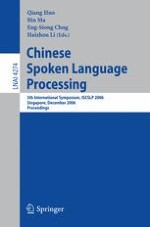2006 | Buch
Chinese Spoken Language Processing
5th International Symposium, ISCSLP 2006, Singapore, December 13-16, 2006. Proceedings
herausgegeben von: Qiang Huo, Bin Ma, Eng-Siong Chng, Haizhou Li
Verlag: Springer Berlin Heidelberg
Buchreihe : Lecture Notes in Computer Science
